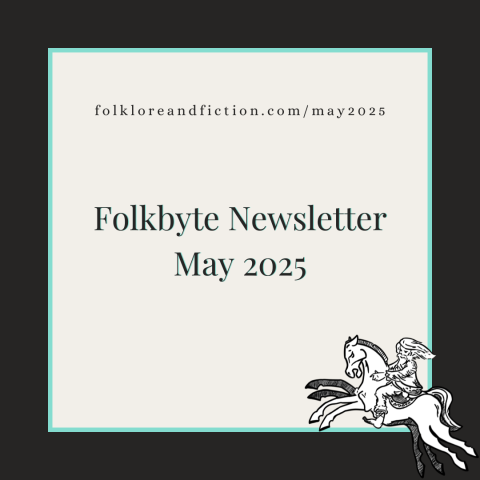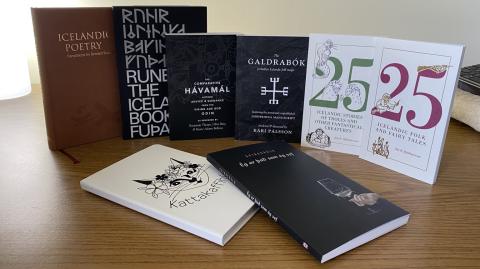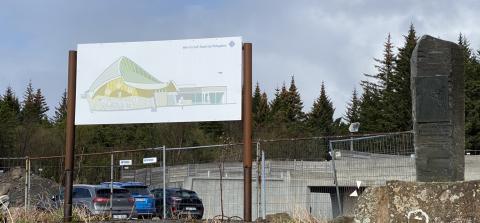
Góðan daginn, and welcome to the May 2025 Folkbyte newsletter, hitting your inbox a day late because I've just returned from a week of publishing events and symposiums in Reykjavik. Here's all the news that's fit to print.
Dispatches from the Word Mines
Reykjavik

On Friday, April 25th, I attended the Sorcery in Iceland symposium at the National Museum of Iceland, which was co-sponsored by Hyldyr Publishing and featured the work of several scholars including Teresa Dröfn Freysdóttir Njarðvík and Kári Pálsson. Teresa is the author of Runes: The Icelandic Book of Fuþark, and Kári is the author of The Galdrabok: forbidden Icelandic folk magic, both pictured in the book hoard I brought home. Hyldyr Publishing co-founder Joseph Hopkins concluded the symposium with a brief discussion of the traditional grimoires Hyldyr has published, including The Long Hidden Friend (forthcoming), which I introduced.
On Saturday, April 26th, an abbreviated version of this symposium was offered to members of the Ásatrúarfélagið on the hof (temple) site, which is presently under construction but already in use by members of the organization. I did take photos both inside and outside of the hof, but out of respect for the organization and because I haven't asked for permission to share pictures of the interior, I'm only sharing a photo of the outside here. Kári delivered a longer version of his paper on the Jarðskinna Manuscript, and the conversation between him and Teresa during the question and answer session was most interesting. I took good notes and plan to cite their observations in The Storyteller's Guide to Folklore. Look for them in the chapters about charms and curses.

Saturday evening, there was folk dancing and singing at the ÆGIR Taproom in downtown Reykjavik. I learned two dances and tasted Brennivin for the first time when a barmaid stepped into the centre of the circling dancers with a bottle and a stack of plastic shot glasses. Later, I offered a bit of Cape Breton to the crowd with a rendition of Hi Rì Him Bò, and all of the dancers and singers present joined in the chorus.
On Sunday, April 27th, I returned to the ÆGIR Taproom for the first ever Hyldyr moot, where Nornabrunnur, the Icelandic branch of Hyldyr, was launched. I met several fellow Hyldyrfolk there, including a few artists on their way to the Icelandic Sorcery Festival. Notables present included Hyldyr co-founder Lauren Fountain, archaeologist Giorgia Sottotetti, author Albert Björn Shiell, and poet Katie Metcalfe along with the aforementioned usual suspects.
I've come away from the trip feeling nourished in ways I have yet to entirely integrate, so I shall leave these and other experiences in the garden of my consciousness to sprout as they will. However, I can write with certainty that Iceland and I still have plenty to do together. I'm also profoundly glad to find myself among the Hyldyrfolk.
The Storyteller's Guide to Folklore
I'm still in discussions with my prospective publisher and prospective agent. I'll let you know when matters are settled!
Last Month on Social Media
Last month I published the final three videos in a six-part series on the folkloristics of charms and curses. You'll find them on YouTube, here:
From the Folklore & Fiction Archive
In March 2019, I released the third Folklore & Fiction dispatch and the second to discuss the folkloristics of traditional narrative and belief. The topic was legend and the ways it might be utilised in storytelling. Here's an excerpt:
I'm going to introduce one more concept before we move on; the contemporary legend, which you might know by the name "urban legend." Gail de Vos writes that contemporary legend structure hangs on three basic elements; authentication, the inclusion of everyday details, and a particular style and tone utilized in the telling. In terms of authentication, tellers of contemporary legends often believe they are true and represent them as such in a few specific ways. The first is an attribution style commonly referred to among folklorists as "friend-of-a-friend" or FOAF. For example, a legend teller might say that the event described in her narrative happened to a neighbour's sister. The second involves situating the narrative in the real world as discussed above. The third is to source the narrative in a reputable mass media outlet such as a major newspaper. Everyday details might include urban locations, technologies, current political concerns, fears about diseases such as HIV/AIDS, and so on. Finally, contemporary legends are told informally in a conversational style that can include what de Vos describes as a "film noir tone," which is often shocking or frightful, may include black humour, and depends upon twist endings for effect.[1]
That's all for now. There's Icelandic nettle and ginger tea in my cup as I write this, or at least, there was. Time for a refill. See you in June.
Yours in fire and ice,
Ceallaigh
Footnotes
- de Vos, Gail. Tales, Rumors, and Gossip: Exploring Contemporary Folk Literature in Grades 7-12. Englewood: Libraries Unlimited, 1996: 5-7.
Dr. Ceallaigh S. MacCath-Moran holds B.A. in Celtic Studies from the University of Toronto, an M.A. in English and Creative Writing from the University of Maine, and a PhD in Folklore from Memorial University of Newfoundland and Labrador. She's also an author, poet, and musician under the names Ceallaigh S. MacCath-Moran and C.S. MacCath. Her long-running Folklore & Fiction project integrates these passions with a focus on folklore scholarship aimed at storytellers, and she brings a deep appreciation of animism, ecology, and folkloristics to her own storytelling. You can find her online at csmaccath.com, folkloreandfiction.com, and linktr.ee/csmaccath.
© 2025 Dr. Ceallaigh S. MacCath-Moran. All rights reserved unless Creative Commons licensing is specifically applied. To read the full "Copyright Statement and Usage Guide," visit https://csmaccath.com/copyright.